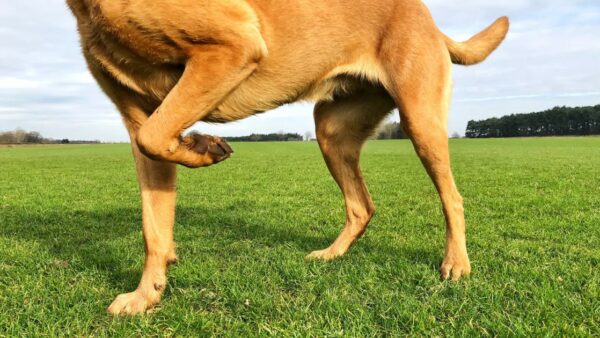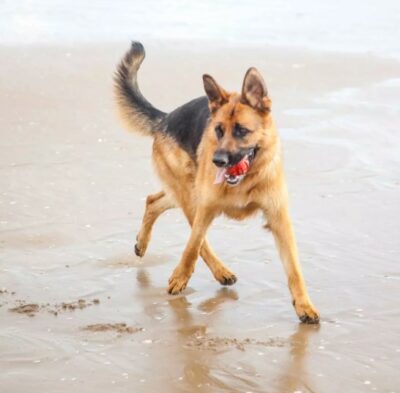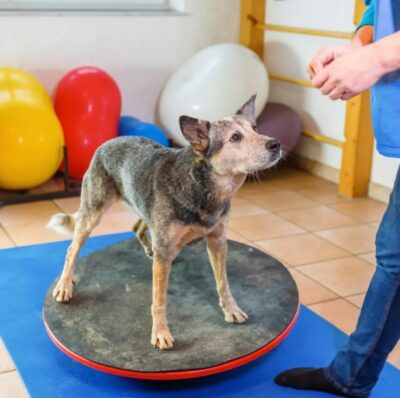What is osteoarthritis in dogs? Symptoms, prevention and natural treatment

READ IN THE TEXT:
Symptoms of osteoarthritis in dogs
Causes of osteoarthritis in dogs
Which dogs have a higher risk of developing osteoarthritis
Diagnosis of osteoarthritis in dogs
How is osteoarthritis treated in dogs?
Osteoarthritis in dogs is a degenerative disease of the synovial joints (the common joints such as hips and knees) and is the most common form of arthritis in dogs. This chronic disease affects about 20% of dogs older than one year and cannot be completely cured.
In dogs with osteoarthritis, progressive damage occurs to the cartilage surfaces of the joints, and fibrosis may also develop around the cartilage of the joints. This eventually leads to pain and reduced function of the joints.
Most cases of osteoarthritis occur as a secondary complication of other conditions, such as hip dysplasia in dogs and a torn anterior cruciate ligament. Other factors contributing to osteoarthritis include body weight, obesity, gender, physical activity and diet. In addition, some dog breeds have a genetic predisposition to developing osteoarthritis.
How can I recognise the signs of osteoarthritis in my dog? 
Your pet may have osteoarthritis if it shows one or more of the following symptoms:
- Reduced desire to play or exercise; lethargy
- Lameness, changes in posture and/or gait pattern
- Difficulty getting up from a sitting position and inability to walk up or down stairs
- Reduced appetite
- Excessive licking of the joint area
- Sudden behavioural changes may indicate dog pain
- Swelling or redness of joints
What are the causes of osteoarthritis in dogs?
Osteoarthritis in dogs is classified as either primary or secondary. Primary osteoarthritis is usually idiopathic, meaning the cause is unknown, or it is related to the dog's ageing.
Secondary osteoarthritis occurs as a result of another medical condition, such as:
- Injuries
- Hip or elbow dysplasia
- Ruptured cruciate ligaments
- Patellaluxation
The dog's age and body weight also play a role in the development of osteoarthritis. Both primary and secondary osteoarthritis develop through a series of changes that affect the health of the joint, cartilage, joint capsule, synovial membranes and ligaments.
Which dogs are at greater risk of developing osteoarthritis? 
Any dog can develop osteoarthritis, and that chance increases with age. However, there are certain dogs with an increased predisposition to developing osteoarthritis, including:
- Large dog breeds, such as the German shepherd, labrador retriever, golden retriever and Great Dane
- Overweight
- Older dogs have higher risk of osteoarthritis
- Dogs whose joints are constantly under pressure from physical activities, such as ball retrieval
- Ligament injuries
- Hip or elbow dysplasia
- Infections affecting the joints, such as Lyme disease
- Improper or poor nutrition
- Genetic predisposition
If your pet has any of these risk factors, it is important to have an annual general health check-up. Your vet can help maintain a healthy weight and active lifestyle, and in most cases will spot early signs of osteoarthritis before the problem becomes serious.
Diagnosis of osteoarthritis in dogs
To diagnose osteoarthritis, your vet will perform a physical examination and perform certain diagnostic tests. The vet will probably start by observing your dog's gait pattern and will note the reduced range of motion of the joints. This includes repetitive movements such as walking and running.
During the physical examination, the vet will also probe the joints to check for swelling or accumulation of fluid. In addition, the vet will check for thickening around the joints and possible muscle atrophy.
In addition to the physical examination, the vet may recommend the following tests:
- Radiological examinations - mostly X-rays, but sometimes a CT scan or MRI may be suggested
- Blood test, if medication is needed for the dog
- Analysis of synovial fluid to rule out infections or possible tumours
- Endoscopy of the affected joints
These tests help in accurate diagnosis and in determining the best treatment options for your dog.
How is osteoarthritis treated in dogs?
Unfortunately, osteoarthritis in dogs cannot be completely cured, but there are several ways to slow the progression of the disease and help your dog enjoy his activities without pain stopping him.
- Natural food supplements
Natural supplements can significantly alleviate the symptoms of osteoarthritis. Glucosamine and chondroitin are the best ingredients for the treatment and relief of joint problems. These substances are part of the synovial fluid and cartilage and work through:- Reduce inflammation
- Promote healing
- Slow down degenerative changes in joints
- Reduce damage to cartilage
Dietary supplements are often used as an early treatment and during the further course of osteoarthritis, as they are safe for long-term use. For the same reason, these supplements can be given preventively to more active dogs to keep joints healthy, especially in dogs with a genetic predisposition to osteoarthritis.
- Medication for pain relief and anti-inflammation
Depending on your dog's condition, the vet may prescribe drug therapy. Common drugs used to treat osteoarthritis in dogs are:
- Non-steroidal anti-inflammatory drugs (NSAIDs)
- Tramadol (a painkiller)
- Chondroprotectiva, such as glucosamine and chondroitin
- Steroids
Medicines such as prednisone, methylprednisolone and triamcinolone are sometimes prescribed to reduce inflammation. However, steroids can have many side effects, so it is essential to use them carefully and only according to the vet's instructions.
- Physiotherapy and alternative therapies

Physiotherapy and alternative treatments can also be helpful for dogs with osteoarthritis. These include:
- Acupuncture
- Laser therapy
- Physical rehabilitation
- Lifestyle changes
Your vet will probably recommend certain lifestyle changes for your dog. Weight loss can be crucial in osteoarthritis, as it reduces inflammation and stress on the joints. Besides specific physical activities, the vet can suggest a special diet and advise you on the right way and amount to feed your pet. - Surgical procedure
Surgery is recommended only in the most serious cases. If the vet considers surgery necessary, he will draw up a rehabilitation plan for after surgery. This may include physiotherapy, massages, swimming and hydrotherapy.
Conclusion
Osteoarthritis is a common joint disease that affects our four-legged friends. Fortunately, although osteoarthritis in dogs cannot be cured, there are many ways to slow the progression of the disease and improve your beloved pet's quality of life.
Regular visits to the vet, maintaining a healthy weight, moderate exercise and the use of nutritional supplements are essential to the care of a dog with osteoarthritis.
